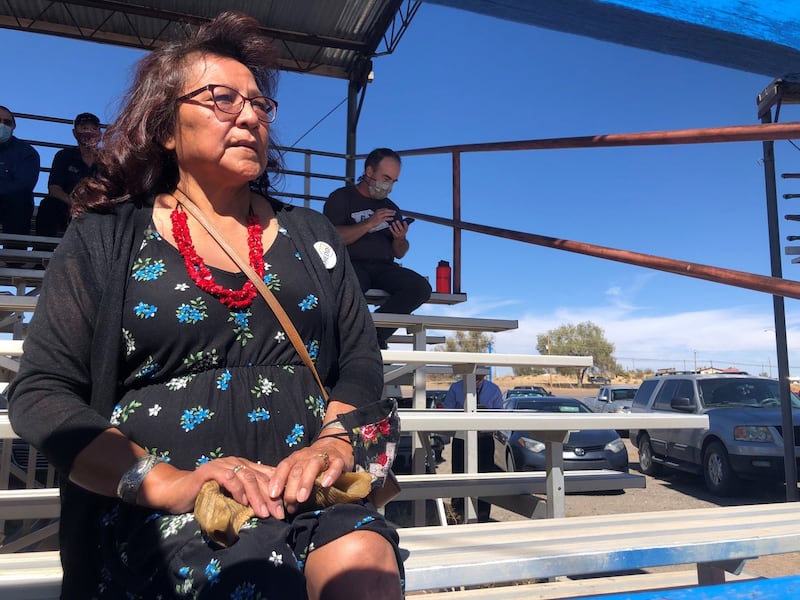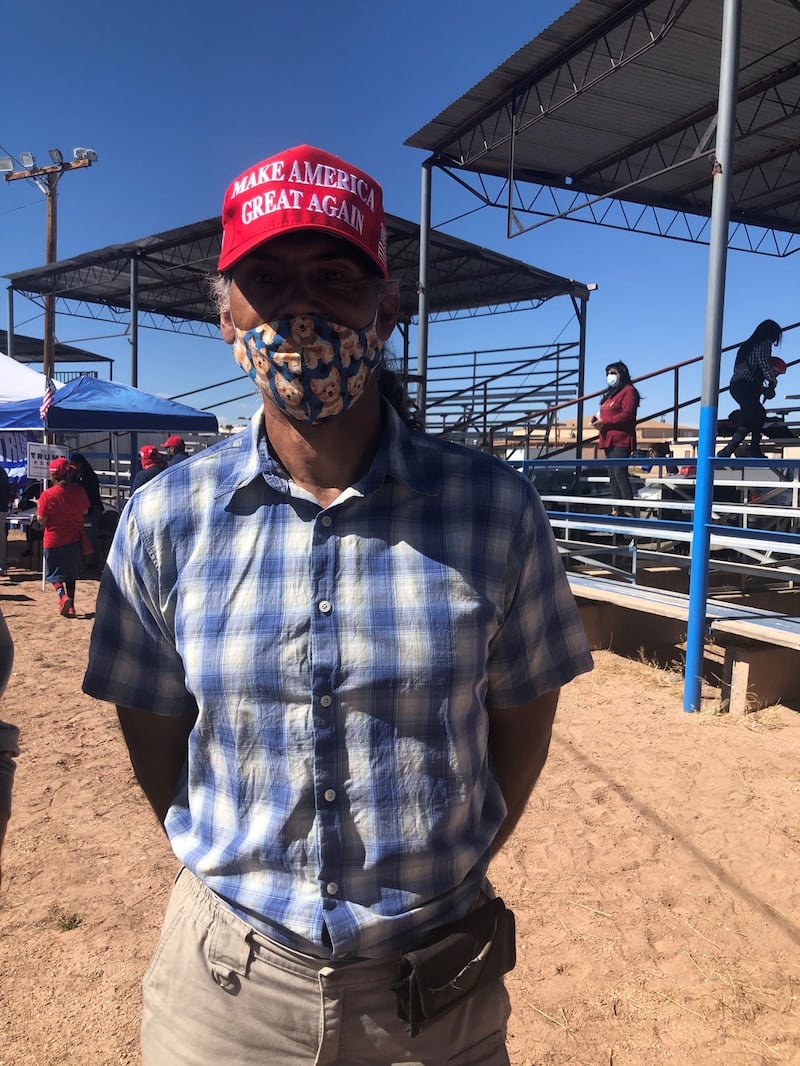It's just after noon at Window Rock on the Arizona-New Mexico border, and a small but vocal group of residents has gathered beneath the searing sun at the local fairground to meet John Pence.
The 31-year-old nephew and senior adviser to vice-president Mike Pence is on a whistle-stop tour through the south west, and is guest of honour at a Navajos for Trump event.
“There’s a movement that the president started, a movement to put America first, to fight for the people in every corner, in every community of this country. From Navajo Nation, to my home state of Indiana, and everywhere else in between. It’s a movement of everyday Americans, from every walk of life that just wants to put our interests and our people first,” he says to cheers.
The Navajo Nation is the largest Native American reservation in the United States, and the most populous of the US's 567 federally-recognised tribes.
The community came to national and international attention this year – not least in Ireland – when it was devastated by Covid-19. More than 10,000 people have tested positive for the virus while approximately 555 Navajo people have died from it – much higher than the national average.
While the death rates peaked in early summer, there has been a resurgence in cases, prompting the local government to impose a curfew last week.
Partnership
The plight of the Navajo people struck a chord with many, including in Ireland, as thousands of peoplecontributed money to help the community through a Go Fund Me page.
It was payback of sorts for a gift given more than 170 years ago by the Choctaw tribe. The native American community, then in the wake of the massive dislocation that pushed native Americans west past the Mississippi, sent $170 to Irish families struggling during the Famine.
Speaking to The Irish Times, Jonathan Nez, the president of the Navajo nation, expresses his gratitude. "We are profoundly grateful to Irish people, as well as other nations throughout the world, who helped us during this time of difficulty in May and June," he says, describing how he first learned about Irish history and connections between the two peoples when the donations began to pour in.
The Native American community has caught the eye of both campaigns as the presidential election day approaches
“It’s a great example of a partnership between nations, of reaching out,” he said, noting t there are “much similarities” between the two peoples’ culture and history. But he also notes that his people needed the help of other countries as “the federal government fails us during these difficult times”.
The coronavirus pandemic has helped refocus attention on the plight of America’s indigenous communities, who were moved off their land during the 19th century and continue to advocate for fairer treatment from the federal government.
Relations between the native communities and the government in Washington run on a government-to-government basis in conjunction with the Bureau of Indian Affairs in DC, though the tribes are recognised as possessing certain inherent rights of self-government.

Lower standards
But the coronavirus pandemic and its disproportionate impact on the community have accentuated the lower standards of health, education and infrastructure that many native people experience.
Here in the dusty lands of the Navajo Nation, only a few hours’ drive from the Grand Canyon, the material reality of the Navajo lifestyle is evident. Many people live in caravans or pre-fab like structures. Some lack running water and electricity.
Though the empty landscape is haunting and beautiful – huge mountains and captivating rock formation shadow the skyline – life here is not easy.
Nez says the pandemic has renewed focus on the lower standards of health and housing afforded to his community. “For example, 30 to 40 per cent of Navajo people don’t have running water, yet NIH [National Institute of Health] and CDC [Center for Disease Prevention and Control] professionals are telling them to wash their hands with soap and water. Broadband and telecommunication is another [issue] – how can we get information out to our citizens?”
The pandemic has also highlighted the difficulty for the Navajo Nation in keeping its residents safe in a territory that spans Arizona, New Mexico, and Utah.
As they wave their flags and hats, it is evident that the commitment of these Trump voters is strong
“I appreciate the Navajo Nation for adhering to the strict restrictions we have imposed. I just wish that other states around us, other governments would do the same,” says Nez, pointing out that one of the reasons for the high coronavirus numbers is down to people from other states with less stringent Covid-19 measures crossing into Navajo.
But while the community enters another phase of curfews and travel limitations in a bid to stave off a second wave, the Native American community has also caught the eye of both campaigns as the presidential election day approaches.
Democratic candidate Joe Biden and his running mate Kamala Harris met members of the community, including Nez, during a visit to Arizona last week. John Pence's trip to the capital, Window Rock, is the latest outreach by the Trump campaign. Though a relatively small voting bloc, native Americans could make a difference in this election, particularly in Arizona, which promises to be one of the closely-fought states on November 3rd.
Just as the presidency of Donald Trump has polarised the country, it has also exposed divisions within the Navajo community.
Divided nation
While Nez is a prominent Biden supporter – he spoke at the Democratic National Convention in August – the vice-president of the nation, Myron Lizer, supports Trump, and delivered a speech at the Republican convention.
Arlyssa Becenti, a journalist with the Navajo Times, says the Trump presidency has served to turn a spotlight on the political views of the nation’s leadership. “People believe that Najavo Nation, because they’re a native tribe, are automatically Democrats and that’s not the case. The Trump administration has been able to bring out the conservative Republican Navajos and vice president Lizer is one of them,” she says.
Before, the question of which political party the leaders belonged to was never really an issue, she says. “But now with this Trump administration, in my opinion it is making the Navajo nation more divided.”
Back at the John Pence rally, enthusiasm for Trump’s agenda is on full display. Most of those attending are wearing “Make America Great Again” hats and other Maga paraphernalia. As Pence, who is introduced by vice-president Lizer, speaks, he is met with drones of enthusiastic approval from blowing horns, a traditional native instrument.
Supporters who have gathered here under the baking desert sun offer different motivations for their stance.

One woman, present with her granddaughter, describes herself as strongly pro-life and says she is voting for Trump because of his stance on abortion. Others talk about their pride in the military. Several people raise their hands when Pence asks if there are any veterans or military families in the audience.
But for many, it is Trump's style, and the perception that he is working for ordinary Americans, that they like. "He's working for the betterment of my country," says Keith Ancar, an Atakapa-Ishak from Louisiana, who has lived in Navajo for more than 20 years.
As they wave their flags and hats, it is evident that the commitment of these voters is strong.
“My uncle likes to say, usually elections are about Republican versus Democrat, conservative versus liberal. This election is about whether America remains America,” declares the young Pence as he concludes his speech, with a call for all native people to get out and vote in November. In this America, “anybody can be anybody,” he says. “Right now we have a president that is standing tall for America – the best is yet to come.”













